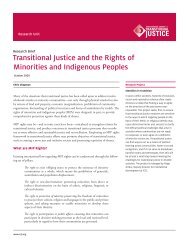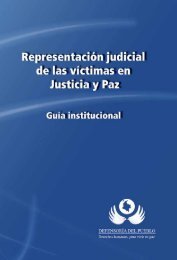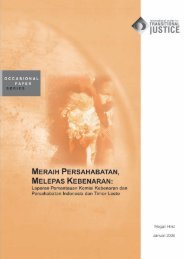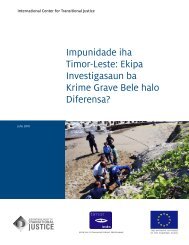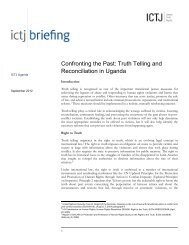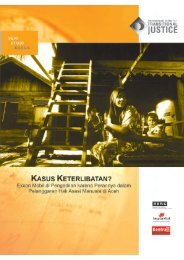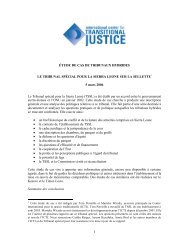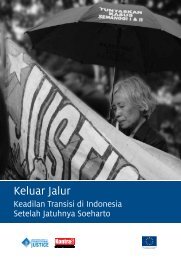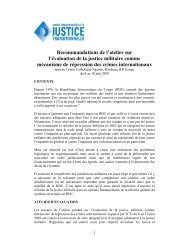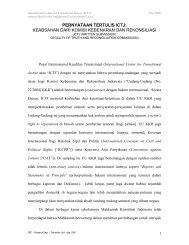That Someone Guilty Be Punished - International Center for ...
That Someone Guilty Be Punished - International Center for ...
That Someone Guilty Be Punished - International Center for ...
Create successful ePaper yourself
Turn your PDF publications into a flip-book with our unique Google optimized e-Paper software.
58. Richard J. Goldstone, For Humanity: Reflections of a War Crimes Investigator, p. 105 (2000).<br />
59. Id.<br />
60. Id., pp. 105–06.<br />
61. Much of the evidence supporting the indictment of Nikolić came from a source who had<br />
fled the region and who had been a guard at a camp where Nikolić murdered, tortured, and illegally<br />
detained Muslim prisoners. The New York Times had published a series of articles based on<br />
this man’s account in August 1994. See Roger Cohen, “Tribunal Charges Serbian Camp Commander<br />
with War Crimes,” New York Times, Nov. 8, 1994. Although indicted in November 1994,<br />
Nikolić eluded arrest until April 20, 2000. See ICTY Web site at http://www.icty.org/x/cases/dragan_nikolic/cis/en/cis_nikolic_dragan.pdf.<br />
62. See Monika Nalepa, “Why Do They Return? Evaluating the Impact of ICTY Justice on Reconciliation,”<br />
p. 30 (Jan. 26, 2007). Michelle Nicholasen, “What about Milosevic?,” Frontline Online (no<br />
date available) at http://www.pbs.org/wgbh/pages/frontline/shows/karadzic/trial/milosevic.html.<br />
63. Charles Trueheart, “War Crimes Tribunal Gathers Momentum; 4 Trials Underway <strong>for</strong> Atrocities<br />
in Bosnia, but top Figures Remain at Large,” Washington Post, Mar. 3, 1998.<br />
64. See Gary J. Bass, “Settling with the Enemy; The Dicey Politics of Negotiating Peace in the<br />
Balkans with Accused War Criminals,” Washington Post, Oct. 29, 1995 (describing opposition by<br />
Europeans to the idea of the ICTY since it was first proposed on the ground “that pursuing this sort<br />
of justice would interfere with peace-making further down the road”); Carla Anne Robbins, “Balkan<br />
Judgments; World Again Confronts Moral Issues Involved in War-Crimes Trials; Some Feel U.N.<br />
Delays Peace in Former Yugoslavia by Pursuing Atrocities,” Wall Street Journal, July 13, 1993.<br />
65. See Jonathan S. Landay, “Opening the docket: trials of a war tribunal,” Christian Science<br />
Monitor, Nov. 16, 1994.<br />
66. The Bosnian Serbs’ military chief, Ratko Mladić, was also routinely engaged by European<br />
diplomats. See Human Rights Watch, Selling Justice Short: Why Accountability Matters <strong>for</strong> Peace, p.<br />
25 (July 2009). http://soc.kuleuven.be/iieb/CPRS/cahiers/Vol83.pdf, at 42–43 and 60–61. Later,<br />
the ICTY prosecutor—by then, Louise Arbour—would face a similar challenge. Her concern that<br />
Slobodan Milošević would escape prosecution if she did not act quickly was among the primary<br />
reasons <strong>for</strong> filing the first Milošević indictment only two months after the beginning of the massive<br />
campaign of ethnic cleansing undertaken by the Serbian and Yugoslav <strong>for</strong>ces in Kosovo in 1999. See<br />
Diane F. Orentlicher, Shrinking the Space <strong>for</strong> Denial: The Impact of the ICTY in Serbia (Open Society<br />
Justice Initiative, 2008), at 35 and 112.<br />
67. As we discuss further in Chapter IV, while Srebrenica is known <strong>for</strong> the massacre of well<br />
over 7,000 males in July 1995, the siege began years earlier.<br />
68. See Pierre Hazan, Justice in a Time of War, p. 66.<br />
69. Richard J. Goldstone, For Humanity, p. 103.<br />
70. Security Council Resolution 836, adopted on June 4, 1993, authorized the UN Protection<br />
Force (UNPROFOR) in Bosnia and UN Member States to use <strong>for</strong>ce to protect so-called “safe areas”<br />
that were under siege. These included Sarajevo, Bihać, Tuzla, Srebrenica, Žepa, and Goražde.<br />
71. Gary Bass writes that the late August 1995 shelling of a marketplace in Sarajevo was, coming<br />
soon after the Srebrenica assault, the last straw that prompted NATO’s response. See Gary Bass,<br />
Stay the Hand of Vengeance, p. 231.<br />
140 NOTES




